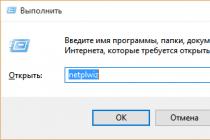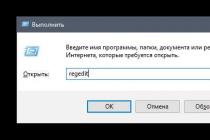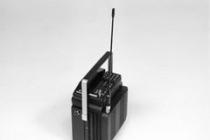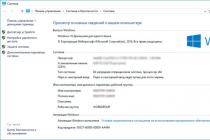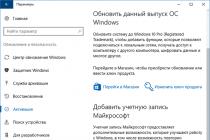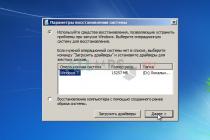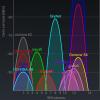The topic of English numbers is quite complex, since the formation of English numbers is different from the education of Russians. There are rules, but there are exceptions, while both have peculiarities. Consider the English numbers with transcription and Russian pronunciation, give vivid examples and focus on the exception. Forward for new knowledge!
Figures in English language are formed in different ways. Numbers from 1 to 10 have some rules of formation, from 13 to 20 - others. Tens, hundreds and thousands also have educational features.
Features of the formation of numbers from 1 to 12
The table below shows the numbers from 1 to 12 with transcription, Russian pronunciation and examples:
| 1 | one | one | |
| 2 | two | [ˈTuː] | that |
| 3 | three | [θriː] | sri |
| 4 | four | od | |
| 5 | five | five | |
| 6 | six | syks | |
| 7 | seven | [ˈSevn̩] | s'evan |
| 8 | eight | eith | |
| 9 | nine | nine | |
| 10 | ten | ten | |
| 11 | eleven | [ɪˈlevn̩] | il'evan |
| 12 | twelve | tU'elv |
- We wanted one cake, two bananas ang eight apples => We wanted one cake, two bananas and eight apples.
- We need to buy avocado fot this recipe. Or better two ones => For this recipe we have to buy an avocado. Or two is better.
- Three kilos of meat, four big tomatoes, five eggplants and garlic will made this evening much more better. I will prepare very delicious dish by my own recipe! => Three kilograms of meat, four large tomatoes, five eggplants and garlic will make the evening much better. I will cook a very tasty dish according to my own recipe!
- Eleven foxes and twelve wolves were seen on this week at this place => Eleven foxes and twelve wolves were seen this week at this place.
Features of the formation of numbers from 13 to 20
| 13 | thirteen | [θɜː'tiːn] | sert'in |
| 14 | fourteen | [ˌFɔː’tiːn] | fort'in |
| 15 | fifteen | [ˌFɪf'tiːn] | lift'in |
| 16 | sixteen | [ˌSɪk'stiːn] | syxt'in |
| 17 | seventeen | [ˌSev (ə) n'tiːn] | sevent'in |
| 18 | eighteen | [ˌEɪ'tiːn] | eyt'in |
| 19 | nineteen | [ˌNaɪn'tiːn] | night'in |
The table shows that numbers from 13 to 19 (inclusive) are written according to the same rules, a particle is added to the cardinal number (one, two, three) –Teen... And do not confuse cardinal numbers with ordinal numbers! in English are formed in a completely different way!
On a note! Remember that there are exceptions to every rule. In this case, the numerals 13 and 15 will be the exceptions. Their root three and five will have a modified form:
- Three => thirteen
- Five => fifteen.
Not threeteen / fiveteen !!!
Some examples:
- Seventeen girls were seen at this part while only eight boys came. - Seventeen girls were seen at the party, while only eight guys came.
- Seventeen pieces of cake were given to all those children. “All these children were given seventeen slices of pie.
- There is a lot of fish in this river. Nineteen kinds were known 5 years ago. - There are many fish in this river. Nineteen species were known five years ago.
Dozens of English numbers
| 20 | twenty | [ˈTwenti] | tU'enti |
| 30 | thirty | [ˈΘɜːti] | S'urty |
| 40 | forty | [ˈFɔːti] | goody |
| 50 | fifty | [ˈFɪfti] | f'ifty |
| 60 | sixty | [ˈSɪksti] | s'yksti |
| 70 | seventy | [ˈSevnti] | s'evanti |
| 80 | eighty | [ˈEɪti] | ‘Hey |
| 90 | ninety | [ˈNaɪnti] | n'inty |
The table clearly shows that tens of numbers are formed using a particle (suffix) –Ty... These numbers are derivatives of cardinal ones, only the -ty suffix needs to be added.
Important! Remember that when the digits 20, 30, 40 and 50 are formed, the root of the quantitative digits that serve as the basis for the formation of tens will change:
- two - 20 twenty [ˈtwenti]
- three - 30 thirty [ˈθɜːti]
- four - 40 forty [ˈfɔːti]
- five - 50 fifty [ˈfɪfti]
And one more nuance: the number 80 [ˈeɪti] is characterized by the absence of repetition of the letter t: eight (eight) = eighty(eight + ty = eightty).
Examples:
- Thirty exotic animals were needed to make the idea of the movie complete => Thirty exotic animals were needed to make the idea of the movie complete.
- Sixty soldiers will come on parade in front of the palace => Sixty soldiers will come to the parade in front of the palace.
- Fifty of them knew the road but only thirty agreed to follow us => Fifty of them knew the road, but only thirty agreed to follow us.
As for the stress of the numerals, which are formed with -ty, then everything is simple - the stress always will be on the first syllable.
Reference: it so happens that it is difficult for beginner students to separate the numbers from -ty and -teen in colloquial speech. And here the stress will come to the rescue - if it is on the first syllable, then 100% we are dealing with dozens of numbers.
Basics of basics: how numbers are formed in English
When studying the formation of English numbers, it is important to remember that numbers from 1 to 12 are simple cardinal numbers. Their task is to indicate the number of items. Such numbers consist of one word. It is very important to remember the spelling of the first twelve digits, since they are marching for the formation of all other digits - from thirteen to a billion.
How are the numbers that are formed by adding the particle –teen pronounced? Here you need to be very careful => the pronunciation of numerals (English numbers) will have two stresses: on the first and second syllables. In this case, we immediately note that the stress will not be equal in strength. One of them will be secondary and the other will be primary.
For example, how is the word thirteen pronounced? From the transcription [ˌθɜːˈtiːn] it can be seen that the word has two stresses. The lower dash indicates the secondary stress, the upper one the primary. The same goes for fourteen [ˌfɔːˈtiːn] and fifteen [ˌfɪfˈtiːn]. There are also two accents here - main and additional.
What to do in order not to be mistaken with the pronunciation? To do this, you must always look at the transcription. Each numeral, like any other word, should be studied according to the following scheme: transcription - translation - the presence of several meanings.
Note! In some dictionaries, the stress of numerals is determined by the presence (absence) of a noun after it. For example, if a numeral is next to a noun, then the stress falls on the first syllable =>
- fifteen rivers [ˈfɪftiːn ˈrɪvər z]
- sixteen cats [ˈsɪkstiːn ˈkæts]
But! If the numeral is in a sentence separately, without a noun, then the stress falls on the second syllable (on the suffix -teen):
- fifteen
- sixteen
Examples:
- Fifteen cats were sold this week => Fifteen cats were sold this week
- How many cats were sold this week? - Fifteen (accented with –teen) => How many cats were sold this week? - Fifteen.
For the convenience of reading and memorizing large numbers, the numbers are divided into so-called "classes": on right separated by three numbers (first class), then three more (second class), etc. The last class can have three, two and one numbers. There is usually a small gap between the classes. For example, the number 35461298 is written as 35 461 298. Here, 298 is the first grade, 461 is the second grade, 35 is the third. Each of the digits of a class is called its rank; the counting of the digits also goes to the right. For example, in the first class 298, the number 8 is the first digit, 9 is the second, 2 is the third. In the last class, there can be three, two digits (in our example: 5 - the first digit, 3 - the second) or one.
The first class gives the number of units, the second - thousands, the third - millions; accordingly, the number 35 461 298 reads: thirty-five million four hundred sixty-one thousand two hundred ninety-eight... Therefore, the unit of the second class is said to be one thousand; the third class unit is a million.
Table, Names of large numbers
| 1 = 10 0 | one |
| 10 = 10 1 | ten |
| 100 = 10 2 | hundred |
| 1 000 = 10 3 | thousand |
| 10 000 = 10 4 | |
| 100 000 = 10 5 | |
| 1 000 000 = 10 6 | million |
| 10 000 000 = 10 7 | |
| 100 000 000 = 10 8 | |
| 1 000 000 000 = 10 9 | billion (billion) |
| 10 000 000 000 = 10 10 | |
| 100 000 000 000 = 10 11 | |
| 1 000 000 000 000 = 10 12 | trillion |
| 10 000 000 000 000 = 10 13 | |
| 100 000 000 000 000 = 10 14 | |
| 1 000 000 000 000 000 = 10 15 | quadrillion |
| 10 000 000 000 000 000 = 10 16 | |
| 100 000 000 000 000 000 = 10 17 | |
| 1 000 000 000 000 000 000 = 10 18 | quintillion |
| 10 000 000 000 000 000 000 = 10 19 | |
| 100 000 000 000 000 000 000 = 10 20 | |
| 1 000 000 000 000 000 000 000 = 10 21 | sextillion |
| 10 000 000 000 000 000 000 000 = 10 22 | |
| 100 000 000 000 000 000 000 000 = 10 23 | |
| 1 000 000 000 000 000 000 000 000 = 10 24 | sepllillion |
| 10 000 000 000 000 000 000 000 000 = 10 25 | |
| 100 000 000 000 000 000 000 000 000 = 10 26 | |
| 1 000 000 000 000 000 000 000 000 000 = 10 27 | octillion |
| 10 000 000 000 000 000 000 000 000 000 = 10 28 | |
| 100 000 000 000 000 000 000 000 000 000 = 10 29 | |
| 1 000 000 000 000 000 000 000 000 000 000 = 10 30 | quintillion |
| 10 000 000 000 000 000 000 000 000 000 000 = 10 31 | |
| 100 000 000 000 000 000 000 000 000 000 000 = 10 32 | |
| 1 000 000 000 000 000 000 000 000 000 000 000 = 10 33 | decillion |
Unit fourth grade called a billion, or, in other words, a billion (1 billion = 1000 million).
A unit of the fifth class is called a trillion (1 trillion = 1000 billion or 1000 billion).
Units sixth, seventh, eighth, etc. classes (each of which is 1000 times larger than the previous one) are called quadrillion, quintillion, sextillion, septillion, etc.
Example: 12,021,306,200,000 reads: twelve trillion twenty one billion three hundred six million two hundred thousand.
This is a tablet for studying numbers from 1 to 100. This manual is suitable for children over 4 years old.
Those who are familiar with Montessori training have probably already seen such a sign. She has many applications and now we will get to know them.
The child must know perfectly the numbers up to 10, before starting to work with the table, since counting up to 10 is the basis for learning numbers up to 100 and above.
Using this table, the child will learn the names of numbers up to 100; count up to 100; sequence of numbers. You can also train to count in 2, 3, 5, etc.
The table can be copied here
It consists of two parts (two-sided). Copy on one side of the sheet a table with numbers up to 100, and on the other, empty cells where you can exercise. Laminate the table so that the child can write on it with markers and wipe it off easily.
How to use the table
 |
1. The table can be used to study numbers from 1 to 100. Starting at 1 and counting up to 100. Initially, the parent / teacher shows how to do this. It is important for the child to notice the principle by which numbers are repeated. |
 |
2. On the laminated table, mark one number. The child should say the next 3-4 numbers. |
 |
3. Mark some numbers. Ask your child for their names. The second version of the exercise - the parent calls arbitrary numbers, and the child finds and marks them. |
 |
4. Counting in 5. The child counts 1,2,3,4,5 and marks the last (fifth) number. |
 |
5. If you once again copy the template with numbers and cut it, you can make cards. They can be arranged in the table as you will see in the following lines. In this case, the table was copied on a blue cardboard that would be easily distinguished from white background table. |
 |
6. Cards can be placed on the table and counted - call a number by placing its card. This helps the child learn all the numbers. In this way he will practice. Before that, it is important that the parent divides the cards by 10 (1 to 10; 11 to 20; 21 to 30, etc.). The child takes a card, puts it down and says a number. |
 |
7. When the child has already advanced with the score, you can go to the empty table and place the cards there. |
 |
8. Counting horizontally or vertically. Arrange the cards in a column or a row and read all the numbers in order, following the regularity of their change - 6, 16, 26, 36, etc. |
 |
9. Write the missing number. The parent writes arbitrary numbers to an empty table. The child must complete the empty cells. |
John Robertson, first Chelsea manager. Below is a list of head coaches football club Chelsea and their main achievements from 1905 to the present. Throughout its history, the club has had 23 head coaches, not counting temporary ones. S ... Wikipedia
Main article: Yekaterinburg Structure of categories containing articles about Yekaterinburg residents: [-] ... Wikipedia
This page is an informational list. Main article: Algorithm The following is a list of algorithms grouped by category. More details are given in the list of data structures and ... Wikipedia
This article contains an unfinished translation from a foreign language. You can help the project by translating it to the end. If you know what language the snippet is written in, include it in this template ... Wikipedia
This page is an informational list. In mathematics, many functions and function groups are so important that they have earned the right to proper names. Below is a list of articles that contain detailed descriptions some of these functions ... Wikipedia
- ... Wikipedia
This page contains a list of the first 500 primes as well as some other prime numbers. Contents 1 First 500 primes 2 Prime numbers Bella ... Wikipedia
There are many mathematical and physical objects named after Leonard Euler: Contents 1 Theorem 2 Lemma 3 Equations 4 ... Wikipedia
Chariot with an umbrella harnessed by four horses from the terracotta army ... Wikipedia
This list contains computer commands Ural 1 Contents 1 Representation of numbers and commands 2 Symbols... Wikipedia
Books
- Special combinatorial numbers. From Stirling numbers to Motzkin numbers: everything about twelve known number sets of combinatorial nature (history, classical properties, examples and problems), EI Deza. Bell numbers, Catalan numbers, Bernoulli numbers ...
In the names of Arabic numbers, each digit belongs to its own category, and every three digits form a class. Thus, the last digit in a number denotes the number of units in it and is called, respectively, the units place. The next, second from the end, number denotes tens (tens place), and the third number from the end indicates the number of hundreds in the number - hundreds place. Further, the categories are repeated in turn in each class in the same way, denoting already units, tens and hundreds in classes of thousands, millions, and so on. If the number is small and does not contain tens or hundreds, it is customary to take them as zero. Classes group numbers in numbers of three, often in calculating devices or records between classes, a period or a space is put in order to visually separate them. This is to make it easier to read large numbers. Each class has its own name: the first three digits are the class of units, followed by the class of thousands, then millions, billions (or billions), and so on.
Since we are using the decimal system, the basic unit of measure for quantity is ten, or 10 1. Accordingly, with an increase in the number of digits in a number, the number of tens also increases 10 2, 10 3, 10 4, etc. Knowing the number of tens, you can easily determine the class and place of the number, for example, 10 16 is tens of quadrillion, and 3 × 10 16 is three tens of quadrillion. The decomposition of numbers into decimal components is as follows - each digit is displayed in a separate summand, multiplied by the required coefficient 10 n, where n is the position of the digit from left to right.
For example: 253 981 = 2 × 10 6 + 5 × 10 5 + 3 × 10 4 + 9 × 10 3 + 8 × 10 2 + 1 × 10 1
Also, the power of 10 is used in writing decimal fractions: 10 (-1) is 0.1 or one tenth. Similarly with the previous paragraph, you can expand the decimal number, n in this case will denote the position of the digit from the comma from right to left, for example: 0.347629 = 3 × 10 (-1) + 4 × 10 (-2) + 7 × 10 (-3) + 6 × 10 (-4) + 2 × 10 (-5) + 9 × 10 (-6 )
Decimal names. Decimal numbers are read according to the last digit after the decimal point, for example 0.325 - three hundred twenty five thousandths, where thousandths is the last digit 5.
Table of names of large numbers, digits and classes
| 1st class unit | 1st digit of the unit 2nd rank tens 3rd rank hundreds |
1 = 10 0 10 = 10 1 100 = 10 2 |
| 2nd class thousand | 1st digit units of thousand 2nd rank tens of thousands 3rd rank hundreds of thousands |
1 000 = 10 3 10 000 = 10 4 100 000 = 10 5 |
| 3rd grade millions | 1st digit unit million 2nd rank tens of millions 3rd rank hundreds of millions |
1 000 000 = 10 6 10 000 000 = 10 7 100 000 000 = 10 8 |
| 4th grade billions | 1st digit unit billion 2nd rank tens of billions 3rd rank hundreds of billions |
1 000 000 000 = 10 9 10 000 000 000 = 10 10 100 000 000 000 = 10 11 |
| 5th grade trillions | 1st rank unit trillion 2nd rank tens trillion 3rd rank hundreds trillion |
1 000 000 000 000 = 10 12 10 000 000 000 000 = 10 13 100 000 000 000 000 = 10 14 |
| 6th grade quadrillion | 1st digit unit of quadrillion 2nd grade tens of quadrillion 3rd rank tens of quadrillion |
1 000 000 000 000 000 = 10 15 10 000 000 000 000 000 = 10 16 100 000 000 000 000 000 = 10 17 |
| 7th grade quintillions | 1st digit unit of quintillion 2nd rank tens of quintillion 3rd rank hundreds of quintillion |
1 000 000 000 000 000 000 = 10 18 10 000 000 000 000 000 000 = 10 19 100 000 000 000 000 000 000 = 10 20 |
| 8th grade sextillion | 1st rank unit of sextillion 2nd rank tens of sextillions 3rd rank hundreds of sextillions |
1 000 000 000 000 000 000 000 = 10 21 10 000 000 000 000 000 000 000 = 10 22 1 00 000 000 000 000 000 000 000 = 10 23 |
| 9th grade septillions | 1st rank unit of septillion 2nd rank tens septillion 3rd rank hundreds of septillion |
1 000 000 000 000 000 000 000 000 = 10 24 10 000 000 000 000 000 000 000 000 = 10 25 100 000 000 000 000 000 000 000 000 = 10 26 |
| 10th grade octillion | 1st digit of the unit of octillion 2nd digit tens of octillion 3rd rank hundreds of octillion |
1 000 000 000 000 000 000 000 000 000 = 10 27 10 000 000 000 000 000 000 000 000 000 = 10 28 100 000 000 000 000 000 000 000 000 000 = 10 29 |




